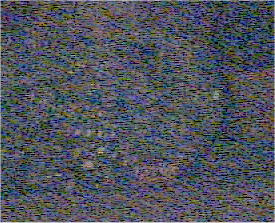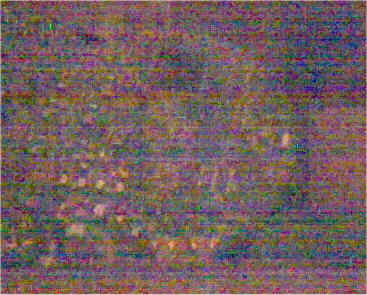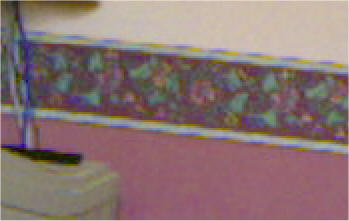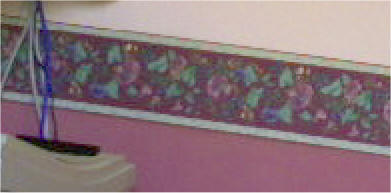 Section of the TouCam Image
Section of the TouCam Image
After reading the reports of the Fusion by Gary Honis I thought I should take a look at this webacm especially as we are beta testing another camera for use as a planet imaging device.
Gary's findings are here.
Basically Gary has found the Fusion to be a higher resolution, with greater sensitivity and greater bandwidth than the ToUCam. Also the individual frames had lower noise than the TouCam and on processing the Fusion gave better results than the ToUCam. Rather strangely Gary found that the Fusions top resolution of 1.3 MP was not accessible using standard software but required a software package like IC Capture.
As I have been one of those on QCUIAG telling people not to buy CMOS webcams this comes as a bit of a shock. How can a webcam with smaller pixels and CMOS rather than CCD be more sensitive. The USB2 interface of the fusion should be an advantage but then we have seen a number of CMOS USB2 webcams (and indeed CCD Firewire and USB2) that still could not compete with the ToUCam.
So thats my reason for getting one. What follows is some first impressions.
The Fusion is a lot smaller than I imagined. It is nicely put together and costs a bit less than the ToUCam (I am comparing here with the ToUCam III or spc900 which I also have at the moment). The software package that come with the camera is great for fun video links etc. I would have finished this a day earlier if I had not been playing around with avatar sharks etc!
The software installs both WDM and direct show drivers. However the WDM drivers do not give the full range of features (eg the 1.3MP streaming mode). As most of the 'standard' astro webcam software uses WDM drivers rather than direct show it means we need to find something different. Rather than using the time limited demo of IC Capture I used Microsoft's free amcap to capture avi's and control the camera. It has to be said the Fusion drivers are a real pain to use and seam to obstruct and turn the camera over to auto control given the slightest chance.
This first question to answer is one of sensitivity. Comparing CMOS and CCD in this was a bit strange as I knew CMOS is a poor cousin to CCD sensitivity. Making a direct comparison is very difficult due to different lenses, and software processing (gain, gamma, brightness etc). For this test I propped a PCB in front of the cameras and turned most of the lights out in the room. Both webcams were removed from their cases and a old QC3000 lens used for both cameras.
Its was immediately apparent that the Fusion drivers were prepared to push the image much further than the ToUCams. The Fusion has a huge amount of gain it can use which results in the image getting swamped by noise. The ToUCam driver was happier giving a less noisy but darker image. To test I went into the drivers and tried to increase the S/N as much as possible for each camera. For both cameras their highest resolution was used and the slowest frame rate and shutter speed.
 Section of the TouCam Image
Section of the TouCam Image
 Same for the Fusion.
Same for the Fusion.
Well... The fusion looks to have pulled off the impossible! Its CMOS, has smaller pixels and is more sensitive! True not massively more sensitive and the Fusion looks to be doing a little noise reduction where the ToUCam image is probably a little closer to what the CCD is seeing, but still against expectations the Fusion is a very sensitive webcam.
Not too much to say here. The Fusion image quality on brightly lit subjects was very good when high resolution and slow frame rates were chosen.
We now take for granted that webcams can be used with telescopes just by removing the lens and screwing in an readily available adaptor. Well this is not the case for the fusion. The lens in this camera is a 10 mm (rather than 12mm that is the norm). So the adaptors will not fit. Further more its doing to be difficult to make something that will as the sensor is bigger than the ToUCam and the thread smaller, also the lens housing is not really fitted to the PCB firmly enough to hold the weight of the camera. The way to go may be to re house the camera in a project box which introduced issues of ensuring the sensor is properly aligned to the optics.
When comparing webcams for astronomy the ToUCam has been the undisputed leader for 3-4 years but the Fusion is a real contender. The camera looks to be able to produce bigger better images than the ToUCam. The down side is that it will be more difficult to fit to a scope and the camera will not work to its full potential with WDM software. Also the TouCam can be modified for deep sky use, this is unlikely to be true for the Fusion (at least in the near future).
So far we have considered the Fusion V Toucam wrt full resolution low frame rate imaging. The Lumenera camera has proved popular, if expensive (~1500 Euros), for planetary imaging as it can give up to 60FPS with no image compression. The camera we are beta testing will be much cheaper but still rather more than the Fusion.
To counter act the effects of poor seeing its good to take many very short exposure pictures. The max frame rate of the Fusion in 1.3MP mode is 7FPS which is not really up to the job. However it can do upto 30FPS in 640x480 mode. This is plenty to capture all the detail that amateur scopes are capable of resolving on Jupiter, Saturn etc.
The camera was aimed at a brightly lit bit of wall. The shutter and gain fixed (1/60, 627) and video collected at 30FPS and 5FPS.
Results

Section from 30FPS sample resized 200%

Same section from AVI collected at 5FPS, again 200% to show detail.
As the frame rates increase the Fusion produces worse quality images.
For the price it offers a great deal for astronomy. If software support follow and an easy way to couple the camera to a telescope, it might (IMO) prove to be better than a ToUCam. Even though the camera is USB2 I have not found a way to get it to return high quality images at high frame rates.
Please keep in mind I have had the camera for less than 48 hours and not got it anywhere near a telescope. If you think I have made any mistakes or have comments please drop me an email at steve@pmdo.com